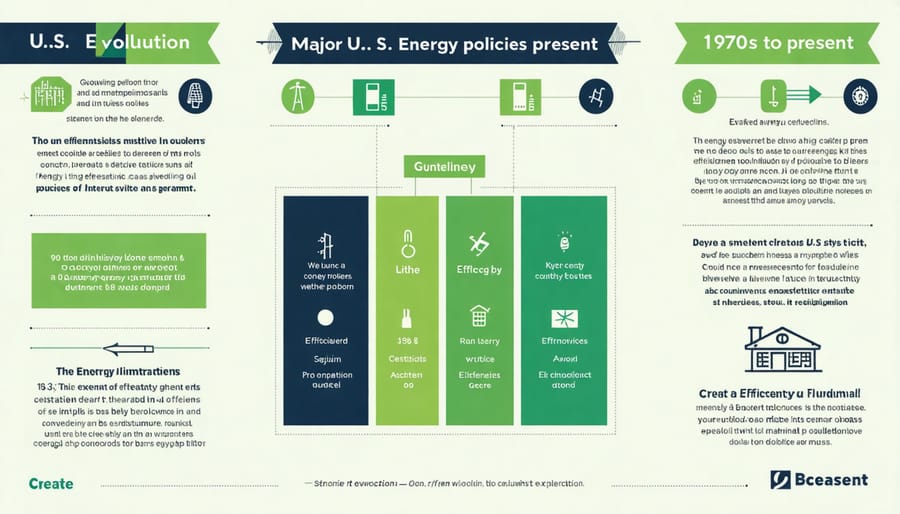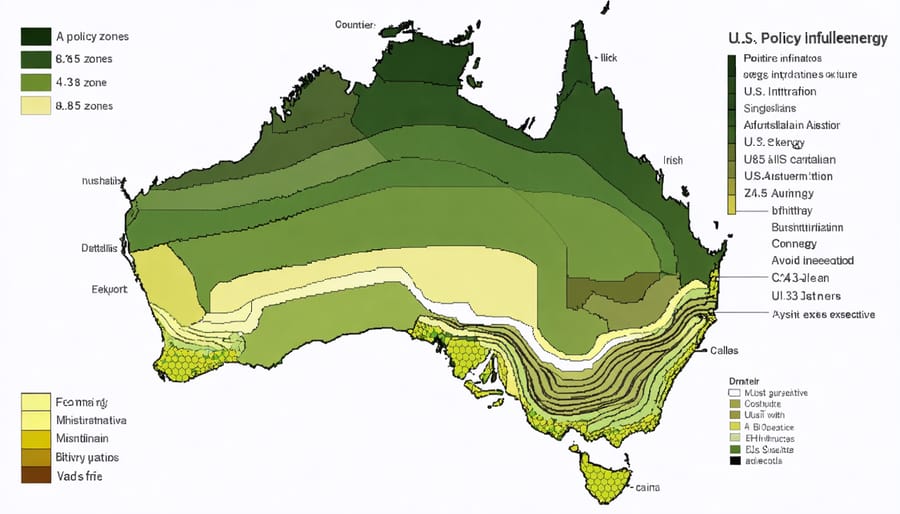America’s energy policy transformation offers a blueprint for Australia’s renewable future, demonstrating how strategic global energy partnerships can accelerate sustainable development. The U.S. journey from fossil fuel dependence to renewable energy leadership reveals critical lessons for Australian policymakers and industry stakeholders. Through innovative state-level renewable portfolio standards, federal tax incentives, and ambitious clean energy targets, the United States has created a robust framework that Australia can adapt and enhance.
Recent American successes in bioenergy development, particularly in agricultural states, showcase how regional resources can be leveraged for national energy security. By examining these achievements – from Iowa’s corn-based ethanol program to California’s comprehensive renewable energy standards – Australia gains practical insights for developing its own biomass potential.
The U.S. model demonstrates that effective energy policy requires three key elements: strong regulatory frameworks, market-based incentives, and consistent investment in research and development. As Australia navigates its energy transition, these proven strategies offer a roadmap for combining economic growth with environmental stewardship, while fostering innovation in renewable technologies.
U.S. Energy Policy Evolution: Setting Global Benchmarks

Landmark Energy Efficiency Legislation
The United States has established several groundbreaking energy efficiency laws that have transformed the nation’s approach to energy consumption and conservation. The National Energy Conservation Policy Act of 1978 laid the foundation for modern energy efficiency standards, introducing guidelines for residential and commercial buildings that continue to influence construction practices today.
A significant milestone came with the Energy Policy Act of 1992, which set new standards for appliances and equipment while promoting renewable energy development. This legislation proved transformative, leading to substantial energy savings and reduced greenhouse gas emissions across industries.
The Energy Independence and Security Act of 2007 marked another leap forward, introducing more stringent vehicle fuel economy standards and phasing out inefficient incandescent light bulbs. This act has helped Americans save billions in energy costs while driving innovation in LED lighting technology and automotive efficiency.
More recently, the Bipartisan Infrastructure Law of 2021 allocated unprecedented funding for energy efficiency improvements, including $3.5 billion for weatherization assistance programs and substantial investments in grid modernization. These initiatives demonstrate how well-crafted legislation can accelerate the transition to a more sustainable energy future while creating economic opportunities and environmental benefits.
The success of these policies has inspired similar initiatives worldwide, offering valuable lessons for countries developing their own energy efficiency frameworks.
Federal vs State Innovation
The United States exemplifies a dynamic interplay between federal and state-level energy innovation, creating a rich landscape of policy experimentation. States often serve as “laboratories of democracy,” pioneering bold initiatives that later influence federal policy. California, for instance, has consistently led the nation with ambitious renewable energy standards and vehicle emission regulations, inspiring similar measures nationwide.
Federal policies provide crucial framework and support through initiatives like the Investment Tax Credit for solar energy and Production Tax Credit for wind power. However, states have shown remarkable creativity in developing their own solutions. Massachusetts pioneered the nation’s first solar carve-out program, while Texas revolutionized wind energy development through its competitive renewable energy zones.
This two-tier approach has proven particularly effective in addressing regional differences. While federal policies ensure baseline standards and coordination, state-level innovation allows for tailored solutions that consider local resources, economic conditions, and community needs. States like Hawaii have developed unique energy storage requirements to address island grid challenges, while Minnesota has created innovative community solar programs.
The success of this federal-state partnership offers valuable lessons for other nations seeking to balance national coordination with local innovation in energy policy development.
Policy Innovation Success Stories
Building Code Transformation
The United States has made remarkable strides in energy efficiency through innovative building code transformations, setting benchmarks that Australia can learn from. The implementation of the International Energy Conservation Code (IECC) and ASHRAE standards has revolutionized how buildings manage energy consumption across America.
A standout success story is California’s Title 24 Building Energy Efficiency Standards, which have helped new buildings reduce energy usage by up to 30% since their introduction. These standards pioneered requirements for solar-ready roofs, smart thermostats, and high-performance insulation, creating a blueprint for sustainable construction that other states quickly followed.
The Department of Energy’s Better Buildings Initiative has been another game-changer, encouraging commercial building owners to reduce energy intensity by 20% over ten years. This program has sparked innovation in building design and retrofit strategies, with participating buildings saving an average of 2.5% in energy costs annually.
Notable transformations include the widespread adoption of automated lighting controls, energy-efficient windows, and advanced HVAC systems. These improvements have been particularly effective in commercial buildings, where smart technology integration has enabled real-time energy monitoring and optimization.
The success of these building codes has inspired a ripple effect across the construction industry, with architects and developers voluntarily exceeding minimum requirements to create ultra-efficient buildings. This transformation has not only reduced energy consumption but also demonstrated that sustainable building practices can be both practical and profitable.
For Australia, these U.S. achievements offer valuable lessons in how progressive building standards can drive industry-wide change while supporting broader energy policy goals.

Appliance Standards Revolution
The transformation of America’s appliance efficiency standards has been one of the most successful yet understated energy policy achievements. Since the introduction of the National Appliance Energy Conservation Act in 1987, these standards have revolutionized how manufacturers design and produce everyday household items, from refrigerators to washing machines.
These requirements have driven remarkable innovations in manufacturing, pushing companies to develop more energy-efficient technologies while maintaining or improving product performance. For instance, modern refrigerators use about a quarter of the electricity they did in the 1970s, despite offering larger capacities and better features.
The economic impact has been substantial, with American consumers saving an estimated $500 per household annually through reduced energy bills. Manufacturers initially expressed concerns about increased production costs, but most have found that efficiency improvements have actually enhanced their competitive edge in the global market.
What makes these standards particularly effective is their continuous evolution. The Department of Energy regularly reviews and updates requirements, ensuring that efficiency targets keep pace with technological advancement. This dynamic approach has created a positive feedback loop, where industry innovation drives new standards, which in turn spark further innovations.
The appliance standards program has become a model for other countries, demonstrating how well-designed efficiency requirements can benefit both consumers and manufacturers. The program has prevented millions of tons of carbon emissions while stimulating technological innovation, proving that environmental protection and economic growth can go hand in hand.
Looking ahead, these standards continue to adapt to new challenges, incorporating smart technology and addressing the growing network of connected home appliances, ensuring their relevance in our evolving energy landscape.
Lessons for Australian Bioenergy Development
Adapting U.S. Standards for Australian Markets
When adapting U.S. energy policies for Australian markets, it’s essential to consider the unique geographical, demographic, and environmental characteristics of the Australian landscape. Successful implementation requires careful modification of U.S. standards to align with Australia’s distinctive energy needs and infrastructure capabilities.
One key adaptation involves scaling decentralized energy systems to suit Australia’s vast rural regions. While the U.S. model emphasizes grid interconnection, Australian implementations often require greater emphasis on standalone systems and microgrids due to the country’s expansive outback areas.
The successful transfer of U.S. renewable portfolio standards (RPS) to Australian markets has demonstrated the value of flexible policy adaptation. By adjusting target percentages and implementation timelines to match Australian capabilities and resources, these standards have helped drive sustainable energy adoption while maintaining grid reliability.
Australian markets have also benefited from modifying U.S. energy efficiency incentive programs. Programs like the U.S. Energy Star certification have been successfully localized to reflect Australian building codes and appliance standards, making them more relevant and achievable for local businesses and consumers.
Community engagement strategies from U.S. programs have been effectively redesigned to resonate with Australian communities. This includes incorporating indigenous perspectives and addressing unique regional challenges, ensuring broader acceptance and participation in renewable energy initiatives.
The key to successful adaptation lies in maintaining the core principles of U.S. energy policies while adjusting implementation methods to suit Australian conditions, creating a more sustainable and resilient energy future for both nations.
Bioenergy Integration Strategies
The United States has demonstrated remarkable success in integrating bioenergy into its national energy portfolio through strategic policy implementations. These strategies offer valuable lessons for Australia’s emerging bioenergy sector. Key initiatives include the Renewable Fuel Standard (RFS) program, which has effectively promoted the production and use of biofuels by setting mandatory blending requirements for transportation fuels.
A particularly successful approach has been the development of regional biomass partnerships, where agricultural communities collaborate with energy producers to create sustainable supply chains. For instance, the corn-belt states have established efficient systems for converting agricultural waste into bioethanol, while forestry-rich regions focus on woody biomass utilization.
Tax incentives have played a crucial role in encouraging private investment in bioenergy infrastructure. The Production Tax Credit (PTC) and Investment Tax Credit (ITC) have been instrumental in making bioenergy projects financially viable. These incentives have supported everything from small-scale biogas digesters on farms to large-scale biomass power plants.
Research and development support through programs like the Department of Energy’s Bioenergy Technologies Office has accelerated innovation in conversion technologies. This model of government-backed research could be particularly relevant for Australia’s unique biomass resources, including sugar cane waste and native forestry residues.
Additionally, the implementation of renewable portfolio standards at the state level has created steady demand for bioenergy, providing market certainty for investors and developers. This decentralized approach allows for regional adaptation while maintaining national momentum toward renewable energy goals.

Future Implementation Roadmap
The United States is poised to implement several groundbreaking energy policy initiatives over the next decade, focusing on three key areas: infrastructure modernization, regulatory framework enhancement, and community engagement. Similar to Australia’s successful rural power transformation, these initiatives will prioritize decentralized energy systems and renewable integration.
The first phase, spanning 2024-2026, will concentrate on upgrading existing power grids to accommodate increased renewable energy capacity. This includes implementing smart grid technologies and establishing energy storage facilities in strategic locations. State-level pilot programs will test new policy frameworks, providing valuable data for nationwide implementation.
The second phase (2026-2028) will focus on streamlining permitting processes for renewable energy projects and developing standardized guidelines for energy storage systems. This period will also see the introduction of enhanced incentive programs for residential and commercial clean energy adoption.
The final phase (2028-2030) emphasizes community-based energy initiatives, including the expansion of microgrids and local energy markets. This approach will ensure equitable access to clean energy while building resilience against climate-related challenges.
Success metrics will include renewable energy adoption rates, greenhouse gas emission reductions, and economic benefits for local communities. Regular policy reviews and stakeholder feedback will guide adjustments to ensure optimal outcomes and sustained progress toward clean energy goals.
As Australia stands at the crossroads of energy transformation, the lessons learned from U.S. energy policies offer valuable insights for shaping our sustainable energy future. The successful implementation of renewable energy initiatives, particularly in states like California and Texas, demonstrates how ambitious targets coupled with supportive policy frameworks can accelerate the transition to clean energy.
Looking ahead, Australia’s energy landscape shows tremendous promise. The combination of abundant natural resources, growing public support for renewable energy, and increasing investment in innovative technologies positions us well for a clean energy transformation. Our vast solar and wind potential, combined with emerging opportunities in bioenergy and green hydrogen, creates a robust foundation for energy independence and environmental stewardship.
Key takeaways from U.S. policy innovations that can benefit Australia include the importance of stable, long-term policy frameworks, the value of market-based mechanisms for emissions reduction, and the effectiveness of state-level leadership in driving change. The success of renewable portfolio standards and tax incentives in the U.S. provides a proven template for Australian policymakers to adapt and enhance.
The path forward requires continued collaboration between government, industry, and communities. By fostering innovation, supporting local manufacturing capabilities, and maintaining strong international partnerships, Australia can build a resilient and sustainable energy sector. The transition also presents significant economic opportunities, from job creation in renewable industries to the development of new export markets for clean energy technologies.
As we move towards 2030 and beyond, Australia’s energy policy innovation will play a crucial role in meeting our climate commitments while ensuring energy security and affordability. By learning from international experiences and building on our natural advantages, we can create a thriving, clean energy economy that benefits both current and future generations.

